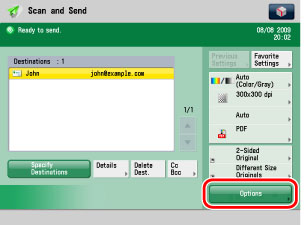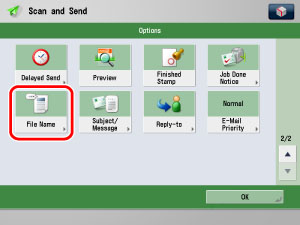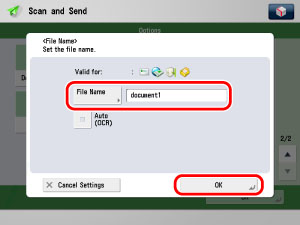You can enter a file name for the document when sending or storing to e-mail, I-fax, server, or mail box. When you store in a mail box, the file name is for the document in the mail box.
|
IMPORTANT
|
|
If you use characters such as ",", "/", "[", or "]" in the document name, you may not be able to send the file to file servers that run on operating systems that do not recognize such characters.
|
|
NOTE
|
|
To cancel this setting, press [Options] → [File Name] → [Cancel Settings].
|
1.
Place your originals and specify the destination → press [Options].

2.
Press [File Name].

3.
Press [File Name] → enter a file name → press [OK].

[Auto(OCR)]:
You can select [Auto(OCR)] only when sending to e-mail or server.
When PDF (OCR) or XPS (OCR) is set as the file format, set [Auto(OCR)] to 'On' to automatically extract the first text block in the document for use as its filename. You can set the number of characters that are extracted for [Auto(OCR)] in <No. of OCR File Name Characters> in OCR (Text Searchable) Settings in Generate File in Common in Function Settings (Settings/Registration). (See "Settings for Creating Searchable PDF/XPS.")
The first text block extracted from the first page of the document is automatically set as the document name. Characters such as ",", "/", "[", or "]", which are invalid when sending a file, will not be extracted.
If a document name is already entered, the extracted text is appended to the end of the filename. Characters over the character limit will be cut off.
The encrypted PDF mode and [Auto(OCR)] cannot be set at the same time.
|
NOTE
|
|
When you are sending documents, each page is sent as a separate image attached to an e-mail message or a separate TIFF image attached to the I-fax, and the extension of the document matches the file format that you select for sending. The file name prefix of the image attached to the e-mail message or I-fax is assigned as follows:
If you set the file name:
The file name prefix is generated by the file name and three digits that signify the page number of the image. Example: file name_002.tif If you do not set the file name:
The file name prefix is generated by the job number (0001 to 4999) and three digits that signify the page number of the image. Example: 1231_002.tif When you are sending documents, each page is sent as a separate image and stored in a file server. The extension of the document matches the file format that you select for sending. The file name prefix of the image attached to the document you are sending is assigned as follows:
If you set the file name and Divide into Pages is turned on:
The file name prefix is generated by the file name, the year, month, day, hour, minute, and second the file is sent, and the five digits that signify the page number of the image. Example: file name_20090707203000_00002.tif file name_20090707203000_00002.jpeg file name_20090707203000_00002.pdf file name_20090707203000_00002.xps If you set the file name and Divide into Pages is not turned on:
The file name prefix is generated by the file name and the year, month, day, hour, minute, and second the file is sent. Example: file name_20090707203000.tif file name_20090707203000.pdf file name_20090707203000.xps If you do not set the file name and Divide into Pages is turned on:
The file name prefix is generated by the year, month, day, hour, minute, and second the file is sent, and the five digits that signify the page number of the image. Example: 20090707203000_00002.tif 20090707203000_00002.jpeg 20090707203000_00002.pdf 20090707203000_00002.xps If you do not set the file name and Divide into Pages is not turned on:
The file name prefix is generated by the year, month, day, hour, minute, and second the file is sent. Example: 20090707203000.tif 20090707203000.pdf 20090707203000.xps You can specify a file name using the Remote UI when sending to an e-mail/I-fax address or a server that is stored in [Favorite Settings]. (See "Specifying a File Name for File/E-mail Transmission via Favorite Settings.")
|
4.
Press [Close].